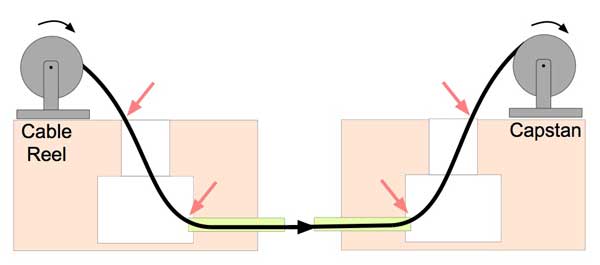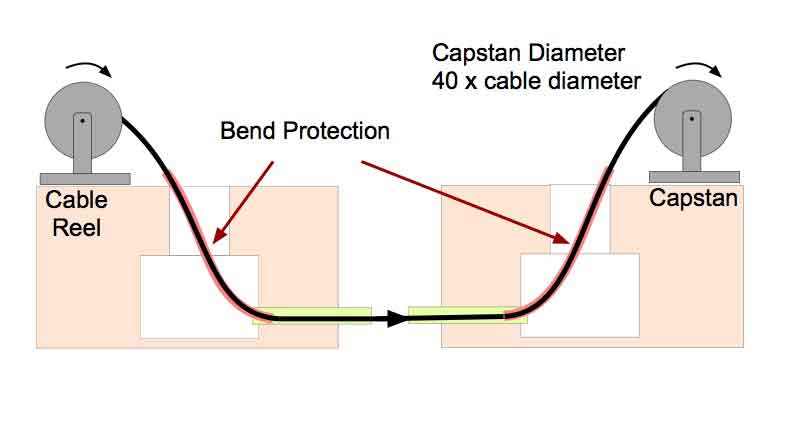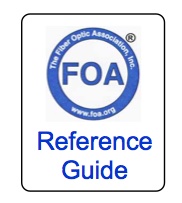Fiber Optic Cable Bend Radius or Diameter
All fiber optic cables have specifications that must not
be exceeded during installation to prevent irreparable
damage to the cable. This includes pulling tension,
minimum bend radius or diameter and crush loads.
Installers must understand these specifications and know
how to install cables without damaging them.
Not following bend radius guidelines can lead to cable
damage. If the cable is damaged in installation, the
manufacturer's warranty is voided. Here is what one
manufacturer's warranty says: "This warranty does not
apply to normal wear and tear or damage caused by
negligence, lack of maintenance, accident, abnormal
operation, improper installation or service, unauthorized
repair, fire, floods, and acts of God."
Bend Radius or Diameter?
Bending of a fiber optic cable can damage the cable if the
curvature of the bend is too small. Damage may not always
be obvious, like a kink in the cable, but may include
broken fibers, fibers with higher loss due to stress and
cable structural damage that may lead to reliability
problems.
Note: The common term for the curvature of the cable is
"bend radius" but sometimes "bend diameter" may be more
useful. For example when a cable is bent around a corner,
bend radius may be appropriate, but if the cable is used
with pulleys or capstans during pulling, then left stored
in loops, the diameter of the pulley, capstan or storage
loop may be more descriptive. Thus we will define
and use both terms.

The diameter of a circle is
the total width across the center and the radius is the
distance from the center to the circumference.
Diameter = 2 X Radius
Typical Specifications
The normal recommendation for fiber optic cable is the
minimum bend radius under tension during pulling is 20
times the diameter of the cable (d). When not under
tension (after installation), the minimum recommended long
term bend radius is 10 times the cable diameter.
Note: Some cables have different specifications, e.g. the
specified minimum bend radius is 15 times the cable
diameter instead of 20 while being pulled and 10 times
under no tension after installation. Some cables are 15
times both under tension and after pulling. Always check
with the manufacturer of the cable you are installing to
ensure you have the proper spec.
For the purposes of this explanation we will use 20 X
while being pulled and 10 X after installation.
Refer to the diagram below: A cable under tension (top)
and after installation (bottom).
R = bend radius
D = bend diameter
d = cable diameter.

If the bend radius spec is
20 times the cable diameter during installation but we're
referring to the diameter of a pulley or a
capstan, the diameter of the pulley or capstan should be 40
times the cable diameter, since the diameter of a
circle is twice the radius.
Likewise, is the bend radius is 10 times the diameter of
the cable after installation, storage loops should
be no smaller in diameter than 20 times the diameter of
the cable.
Note: Always check the cable specifications for cables you
are installing as some cables such as the high fiber count
cables have different bend radius specifications from
regular cables!
Bend radius example:
A cable 13mm (0.5") diameter (d) would have a minimum bend
radius under tension of 20 X 13mm = 260mm (20 x 0.5" =
10")
If you are pulling this cable over a pulley, that pulley
should have a minimum radius of 260mm/10" or a diameter of
520mm/20" - don't get radius and diameter mixed up!
Pulling Cable

Example of cable bend radius violations:
(1) the cable is being pulled out of the conduit up out of
the manhole at an extreme angle, exceeding the cable bend
radius where it exits the conduit.
(2) the pulley on the truck used to turn the cable toward
the capstan pulling it is 5-6 times too small for the
cable - the red dotted circle shows the proper diameter.
We should also add that having the capstan at a right
angle to the cable direction is wrong - the truck and the
capstan should be aligned with the cable pull direction to
avoid use of the pulley altogether.

When pulling underground cable in conduit,
the cable needs protection at the end of the conduit and
at the mouth of the manhole or handhole. This can be done
with several techniques, e.g. sheaves, quadrants or
flexible ducts.

More
on pulling cable in conduit underground
Underground Cable Storage - Manholes and Handholes
After pulling cable, excess cable must be stored, usually
in manholes or handholes. Those should be large enough to
allow the cable to be stored with loops larger than the
recommended bend diameter.

Right and wrong ways to manage manholes or
handholes
Aerial Cable Installation

There are also bend radius issues with
aerial installation, depending on whether the installation
is lashed, ADSS or figure 8 cable and the installation is
done with the moving reel or stationery reel method. The
size of pulleys, cable in storage loops, points of
transition up or down the pole, etc. can involve bends in
the cable that require careful monitoring.
Aerial Cable Storage
After cable installation and splicing, aerial cable is
typically stored in service loops lashed to the
messenger. The ends of the loops must be kept within specs
for bend radius, often using plastic "snowshoes" that are
then suspended from the messenger.

Aerial closure properly attached to messenger and cables

Two "snowshoes" for service loops, one has not been
secured to the messenger and is hanging down, stressing
the cable beyond its bend radius limits.
Premises Cabling Installation
Premises
cable also has issues with bend radius as cables may be
installed below floors, above ceilings and are routed
around many obstacles. Many premises installations use
small diameter orange duct or cable trays to prevent
bending the cable or other damage to the cable after
installation. Hardware for mounting storage loops on the
wall are also recommended.

Proper premises cabling installation using cable trays and
innerduct.
More
on Outside Plant Construction and Installation
|

